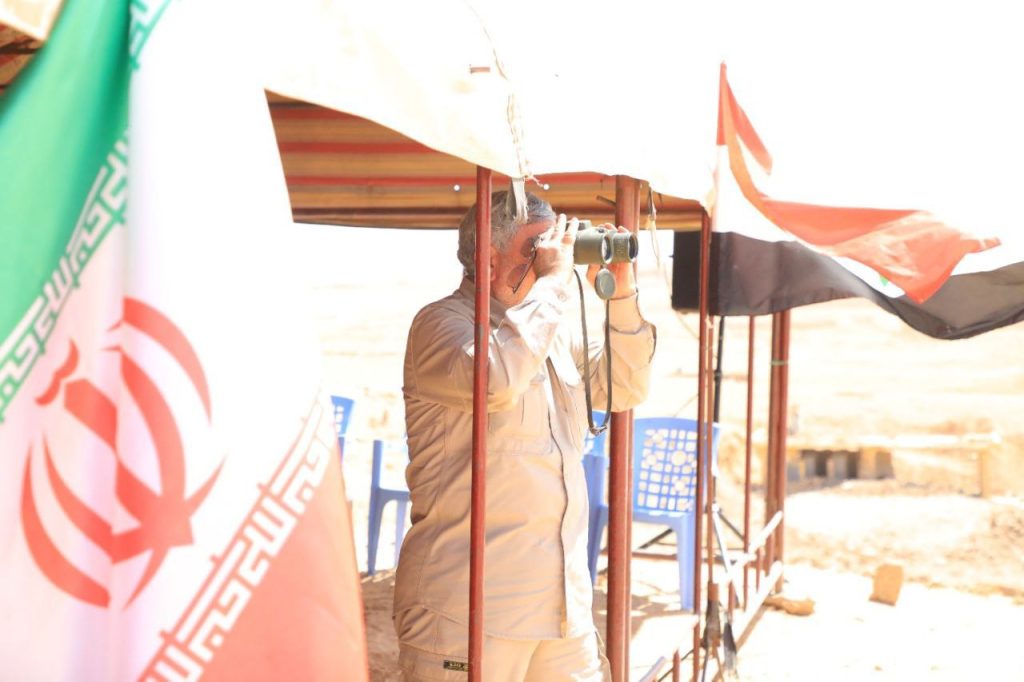Since assuming command of the Quds Force in the Iranian Revolutionary Guards, Ismail Qaani, following in the footsteps of his predecessor, Qassem Soleimani, has consistently disregarded borders and diplomatic protocols pertaining to Syria. Periodically, photos and videos of his unannounced visits to operational areas have surfaced, often becoming public knowledge only after the fact.
His most recent visit occurred just two days ago when the Iranian Tasnim news agency reported Qaani’s arrival in the Syrian capital, Damascus. During this visit, he engaged with security and military officials and oversaw military exercises believed to have taken place in al-Bukamal, a region where Revolutionary Guards-affiliated militias are active.
The Assad regime has traditionally remained tight-lipped about these frequent visits, which include both Qaani and his predecessor Soleimani, who was assassinated in a US strike at Baghdad airport in 2020. The regime neither acknowledges the means by which the Quds Force commander enters the country nor the apparent violation of national sovereignty and diplomatic norms.
Jordanian King: I Doubt Bashar al-Assad Fully Controls His Country
Qaani’s visit coincided with Syrian President Bashar al-Assad’s trip to China, raising suspicions about the timing. According to Tasnim, during his visit, Qaani conducted inspections of various operational areas and held meetings with a range of officials, including military, security, and political figures in Damascus. He also participated in joint military exercises and conducted assessments of sensitive Syrian areas and strategic axes as part of a collective effort to address the country’s military and security challenges.
The Iranian news agency quoted the Quds Force commander as accusing the United States of being the primary source of corruption, chaos, terrorism, and conflict in Syria, the wider region, and the world. This rhetoric aligns with Iran’s consistent stance on Syria, which has been emphasized increasingly in recent weeks. Simultaneously, Iraqi media outlets with close ties to the Assad regime have reported “suspicious American movements” along the Iraqi-Syrian border and in the al-Tanf area.
What is behind Qaani’s visits?
After the assassination of Qassem Soleimani by a US airstrike near Baghdad airport, Iran’s Supreme Leader Ali Khamenei swiftly appointed Ismail Qaani as the new commander of the Quds Force. Mahmoud al-Bazi, an expert on Iranian affairs, asserts that Soleimani left a profound legacy, and Qaani is endeavouring to fill his shoes in Syria and the broader region. Bazi suggests that Qaani is striving to reassert his role through his recurring visits, the most recent of which occurred just two days ago.
Comparing Soleimani and Qaani proves challenging, as noted by Saad al-Shara, a Syrian researcher at the Orient Center for Studies. Shara emphasizes that Soleimani possessed a commanding presence, charisma, and a deeper understanding of military and security operations than his successor.
Furthermore, Soleimani enjoyed greater popularity among militia members deployed in Syria, Iraq, and Lebanon compared to the current Quds Force commander, Qaani.
These repeated visits carry several strategic messages and goals. Firstly, they serve to convey the idea that the areas where Iran has a presence, either directly or indirectly through its militias, are intimately connected to Iran. Secondly, these visits challenge the established political and diplomatic protocols typically observed during VIP visits to foreign countries.
Interestingly, Assad regime officials have expressed surprise at Qaani’s presence in Syria, signaling that Syria, as well as Iraq and Lebanon, are becoming increasingly comfortable with Iran’s influence. Iran appears to treat these nations as if they were “colonies,” disregarding the presence of its influential allies, such as the Assad regime.
Furthermore, the focus of Qaani’s visits on the western bank of the Euphrates River in the Syrian desert carries a message directed at the United States, particularly in the eastern Euphrates and the Tanf region. This message may be an implicit assertion of Iran’s presence and influence in this region, which has been a point of contention between the United States and Iran.
This article was translated and edited by The Syrian Observer. The Syrian Observer has not verified the content of this story. Responsibility for the information and views set out in this article lies entirely with the author.


